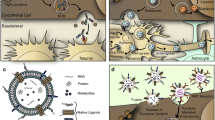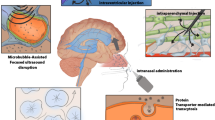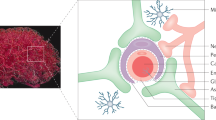Abstract
The development of gene- and RNA interference (RNAi)-based therapeutics represents a challenge for the drug delivery field. The global brain distribution of DNA genes, as well as the targeting of specific regions of the brain, is even more complicated because conventional delivery systems, i.e. viruses, have poor diffusion in brain when injected in situ and do not cross the blood–brain barrier (BBB), which is only permeable to lipophilic molecules of less than 400 Da. Recent advances in the “Trojan Horse Liposome” (THL) technology applied to the transvascular non-viral gene therapy of brain disorders presents a promising solution to the DNA/RNAi delivery obstacle. The THL is comprised of immunoliposomes carrying either a gene for protein replacement or small hairpin RNA (shRNA) expression plasmids for RNAi effect, respectively. The THL is engineered with known lipids containing polyethyleneglycol (PEG), which stabilizes its structure in vivo in circulation. The tissue target specificity of THL is given by conjugation of ∼1% of the PEG residues to peptidomimetic monoclonal antibodies (MAb) that bind to specific endogenous receptors (i.e. insulin and transferrin receptors) located on both the BBB and the brain cellular membranes, respectively. These MAbs mediate (a) receptor-mediated transcytosis of the THL complex through the BBB, (b) endocytosis into brain cells and (c) transport to the brain cell nuclear compartment. The present review presents an overview of the THL technology and its current application to gene therapy and RNAi, including experimental models of Parkinson’s disease and brain tumors.












Similar content being viewed by others
References
K. W. Mok, A. M. Lam, and P. R. Cullis. Stabilized plasmid-lipid particles: factors influencing plasmid entrapment and transfection properties. Biochim. Biophys. Acta 1419:137–150 (1999).
N. Shi, and W. M. Pardridge. Noninvasive gene targeting to the brain. Proc. Natl. Acad. Sci. U. S. A 97:7567–7572 (2000).
W. M. Pardridge. Drug and gene delivery to the brain: the vascular route. Neuron. 36:555–558 (2002).
A. P. Byrnes, J. E. Rusby, M. J. Wood, and H. M. Charlton. Adenovirus gene transfer causes inflammation in the brain. Neuroscience 66:1015–1024 (1995).
M. J. Wood, H. M. Charlton, K. J. Wood, K. Kajiwara, and A. P. Byrnes. Immune responses to adenovirus vectors in the nervous system. Trends Neurosci. 19:497–501 (1996).
J. G. Smith, S. E. Raper, E. B. Wheeldon, D. Hackney, K. Judy, J. M. Wilson, and S. L. Eck. Intracranial administration of adenovirus expressing HSV-TK in combination with ganciclovir produces a dose-dependent, self-limiting inflammatory response. Hum. Gene Ther. 8:943–954 (1997).
M. J. Driesse, A. J. Vincent, P. A. Sillevis Smitt, J. M. Kros, P. M. Hoogerbrugge, C. J. Avezaat, D. Valerio, and A. Bout. Intracerebral injection of adenovirus harboring the HSVtk gene combined with ganciclovir administration: toxicity study in nonhuman primates. Gene Ther. 5:1122–1129 (1998).
U. Herrlinger, C. M. Kramm, K. S. Aboody-Guterman, J. S. Silver, K. Ikeda, K. M. Johnston, P. A. Pechan, R. F. Barth, D. Finkelstein, E. A. Chiocca, D. N. Louis, and X. O. Breakefield. Pre-existing herpes simplex virus 1 (HSV-1) immunity decreases, but does not abolish, gene transfer to experimental brain tumors by a HSV-1 vector. Gene Ther. 5:809–819 (1998).
M. M. McMenamin, A. P. Byrnes, H. M. Charlton, R. S. Coffin, D. S. Latchman, and M. J. Wood. A gamma34.5 mutant of herpes simplex 1 causes severe inflammation in the brain. Neuroscience 83:1225–1237 (1998).
R. A. Dewey, G. Morrissey, C. M. Cowsill, D. Stone, F. Bolognani, N. J. Dodd, T. D. Southgate, D. Klatzmann, H. Lassmann, M. G. Castro, and P. R. Lowenstein. Chronic brain inflammation and persistent herpes simplex virus 1 thymidine kinase expression in survivors of syngeneic glioma treated by adenovirusmediated gene therapy: implications for clinical trials. Nat. Med. 5:1256–1263 (1999).
M. S. Lawrence, H. G. Foellmer, J. D. Elsworth, J. H. Kim, C. Leranth, D. A. Kozlowski, A. L. Bothwell, B. L. Davidson, M. C. Bohn, and D. E. Redmond, Jr. Inflammatory responses and their impact on beta-galactosidase transgene expression following adenovirus vector delivery to the primate caudate nucleus. Gene Ther. 6:1368–1379 (1999).
Y. Stallwood, K. D. Fisher, P. H. Gallimore, and V. Mautner. Neutralisation of adenovirus infectivity by ascitic fluid from ovarian cancer patients. Gene Ther. 7:637–643 (2000).
M. J. Driesse, M. C. Esandi, J. M. Kros, C. J. Avezaat, C. Vecht, C. Zurcher, I. Van der Velde, D. Valerio, A. Bout, and P. A. Sillevis Smitt. Intra-CSF administered recombinant adenovirus causes an immune response-mediated toxicity. Gene Ther. 7:1401–1409 (2000).
K. Kajiwara, A. P. Byrnes, Y. Ohmoto, H. M. Charlton, M. J. Wood, and K. J. Wood. Humoral immune responses to adenovirus vectors in the brain. J. Neuroimmunol. 103:8–15 (2000).
H. Matsui, L. G. Johnson, S. H. Randell, and R. C. Boucher. Loss of binding and entry of liposome-DNA complexes decreases transfection efficiency in differentiated airway epithelial cells. J. Biol. Chem. 272:1117–1126 (1997).
L. G. Barron, L. S. Uyechi, and F. C. Szoka, Jr. Cationic lipids are essential for gene delivery mediated by intravenous administration of lipoplexes. Gene Ther. 6:1179–1183 (1999).
G. Osaka, K. Carey, A. Cuthbertson, P. Godowski, T. Patapoff, A. Ryan, T. Gadek, and J. Mordenti. Pharmacokinetics, tissue distribution, and expression efficiency of plasmid [33P]DNA following intravenous administration of DNA/cationic lipid complexes in mice: use of a novel radionuclide approach. J. Pharm. Sci. 85:612–618 (1996).
N. Shi, R. J. Boado, and W. M. Pardridge. Receptor-mediated gene targeting to tissues in vivo following intravenous administration of pegylated immunoliposomes. Pharm. Res. 18:1091–1095 (2001).
N. Shi, Y. Zhang, C. Zhu, R. J. Boado, and W. M. Pardridge. Brain-specific expression of an exogenous gene after i.v. administration. Proc. Natl. Acad. Sci. U.S.A. 98:12754–12759 (2001).
Y. Zhang, F. Calon, C. Zhu, R. J. Boado, and W. M. Pardridge. Intravenous nonviral gene therapy causes normalization of striatal tyrosine hydroxylase and reversal of motor impairment in experimental parkinsonism. Hum. Gene Ther. 14:1–12 (2003).
Y. Zhang, Y. F. Zhang, J. Bryant, A. Charles, R. J. Boado, and W. M. Pardridge. Intravenous RNA interference gene therapy targeting the human epidermal growth factor receptor prolongs survival in intracranial brain cancer. Clin. Cancer Res. 10:3667–3677 (2004).
D. Papahadjopoulos, T. M. Allen, A. Gabizon, E. Mayhew, K. Matthay, S. K. Huang, K. D. Lee, M. C. Woodle, D. D. Lasic, C. Redemann. Sterically stabilized liposomes: improvements in pharmacokinetics and antitumor therapeutic efficacy. Proc. Natl. Acad. Sci. U. S. A. 88:11460–11464 (1991).
A. Gabizon, D. Papahadjopoulos. Liposome formulations with prolonged circulation time in blood and enhanced uptake by tumors. Proc. Natl. Acad. Sci. U.S.A. 85:6949–6953 (1988).
Y. Zhang, F. Schlachetzki, and W. M. Pardridge. Global non-viral gene transfer to the primate brain following intravenous administration. Molec. Ther. 7:11–17 (2003).
F. Schlachetzki, Y. Zhang, R. J. Boado, and W. M. Pardridge. Gene therapy of the brain: the trans-vascular approach. Neurology. 62:1275–1281 (2004)
M. J. Coloma, H. J. Lee, A. Kurihara, E. M. Landaw, R. J. Boado, S. L. Morrison, and W. M. Pardridge. Transport across the primate blood–brain barrier of a genetically engineered chimeric monoclonal antibody to the human insulin receptor. Pharm. Res. 17:266–274 (2000).
R. J. Boado, Y-F. Zhang, Y. Zhang, and W. M. Pardridge. Humanization of antihuman insulin receptor antibody for drug targeting across the human blood–brain barrier. Biotechnol. Bioeng. 96:381–391 (2007).
W. M. Pardridge. Gene targeting in vivo with pegylated immunoliposomes. Methods Enzymol. 373:507–528 (2003).
A. Gabizon. Stealth liposomes and tumor targeting: one step further in the quest for the magic bullet. Clin. Cancer Res. 7:223–225 (2001).
Y. Zhang, H. Jeong Lee, R. J. Boado, and W. M. Pardridge. Receptor-mediated delivery of an antisense gene to human brain cancer cells. J. Gene Med. 4:183–194 (2002).
Y. Zhang, R. J. Boado, and W. M. Pardridge. Marked enhancement in gene expression by targeting the human insulin receptor. J. Gene Med. 5:157–163 (2003).
Y. Zhang, R. J. Boado, and W. M. Pardridge. In vivo knockdown of gene expression in brain cancer with intravenous RNAi in adult rats. J. Gene Med. 5:1039–1045 (2003).
Y. Zhang, F. Schlachetzki, Y. F. Zhang, R. J. Boado, and W. M. Pardridge. Normalization of striatal tyrosine hydroxylase and reversal of motor impairment in experimental Parkinsonism with intravenous nonviral gene therapy and brainspecific promoter. Hum. Gene Ther. 15:339–350 (2004).
D. A. Jans. Nuclear signaling pathways for polypeptides ligands and their membrane receptors. FASEB J. 8:841–847 (1994).
D. He, W. Casscells, D. A. Engler. Nuclear accumulation of exogenous DNA fragments in viable cells mediated by FGF-2 and DNA release upon cellular injury. Exp. Cell Res. 265:31–45 (2001).
K. M. Haan, A. Aiyar, R. Longnecker. Establishment of latent Epstein–Barr virus infection and stable episomal maintenance in urine B-cell lines. J. Virol. 75:3016–3020 (2001).
S. Makrides. Components of vectors for gene transfer and expression in mammalian cells. Protein Exp. Purif. 17:181–202 (1999).
R. J. Boado, and W. M. Pardridge. Ten nucleotide cis element in the 3′-untranslated region of the GLUT1 glucose transporter mRNA increases gene expression via mRNA stabilization. Mol. Brain Res. 59:109–113 (1998).
R. J. Boado, W. M. Pardridge. Amplification of gene expression using both 5’- and 3’-untranslated regions of GLUT1 glucose transporter mRNA. Mol. Brain Res. 63:371–374 (1999).
C. Chu, Y. Zhang, R. J. Boado, and W. M. Pardridge. Decline in exogenous gene expression in primate brain following intravenous administration is due to plasmid degradation. Pharm. Res. 23:1586–1590 (2006).
Y. Zhang, F. Schlachetzki, J. Y. Li, R. J. Boado, W. M. Pardridge. Organ-specific gene expression in the rhesus monkey eye following intravenous non-viral gene transfer. Mol. Vis. 9:465–472 (2003).
M. M. Mouradian, and T. N. Chase. Gene therapy for Parkinson’s disease: an approach to the prevention or palliation of levodopa-associated motor complications. Exp. Neurol. 144:51–57 (1997).
R. Mandil, E. Ashkenazi, M. Blass, I. Kronfeld, G. Kazimirsky, G. Rosenthal, F. Umansky, P. S. Lorenzo, P. M. Blumberg, and C. Brodie. Protein kinase Calpha and protein kinase Cdelta play opposite roles in the proliferation and apoptosis of glioma cells. Cancer Res. 61:4612–4619 (2001).
I. Nagatsu, H. Ichinose, M. Sakai, K. Titani, M. Suzuki, and T. Nagatsu. Immunocytochemical localization of GTP cyclohydrolase I in the brain, adrenal gland, and liver of mice. J. Neural. Transm. Gen. Sect. 102:175–188 (1995).
O. Hwang, H. Baker, S. Gross, and T. H. Joh. Localization of GTP cyclohydrolase in monoaminergic but not nitric oxide-producing cells. Synapse. 28:140–153 (1998).
M. Shimoji, K. Hirayama, K. Hyland, and G. Kapatos. GTP cyclohydrolase I gene expression in the brains of male and female hph-1 mice. J. Neurochem. 72:757–764 (1999).
I. Nagatsu, R. Arai, M. Sakai, Y. Yamawaki, T. Takeuchi, N. Karasawa, and T. Nagatsu. Immunohistochemical colocalization of GTP cyclohydrolase I in the nigrostriatal system with tyrosine hydroxylase. Neurosci Lett. 224:185–188 (1997).
N. Kaneda, T. Sasaoka, K. Kobayashi, K. Kiuchi, I. Nagatsu, Y. Kurosawa, K. Fujita, M. Yokoyama, T. Nomura, M. Katsuki, and et al. Tissue-specific and highlevel expression of the human tyrosine hydroxylase gene in transgenic mice. Neuron. 6:583–594 (1991).
N. Min, T. H. Joh, K. S. Kim, C. Peng, and J. H. Son. 5’ upstream DNA sequence of the rat tyrosine hydroxylase gene directs high-level and tissue-specific expression to catecholaminergic neurons in the central nervous system of transgenic mice. Mol. Brain Res. 27:281–289 (1994).
M. McManus, and P. Sharp. Gene silencing in mammals by small interfering RNAs. Genetics. 3:737–747 (2002).
J. Couzin. Breakthrough of the year. Small RNAs make a big splash. Science. 298:2296–2297 (2002).
P. Paddison, A. Caudy, E. Bernstein, G. Hannon, and D. Conklin. Short hairpin RNAs (shRNAs) induce sequence-specific silencing in mammalian cells. Genes Dev. 16:948–958 (2002).
G. Sui, C. Soohoo, E. Affar, F. Gay, Y. Shi, W. C. Forrester, and Y. Shi. A DNA vector-based RNAi technology to suppress gene expression in mammalian cells. Proc. Natl. Acad. Sci. U.S.A. 99:5515–5520 (2002).
S. M. Elbashir, J. Harborth, K. Weber, and T. Tuschl. Analysis of gene function in somatic mammalian cells using small interfering RNAs. Methods. 26:199–213 (2002).
T. R. Brummelkamp, R. Bernards, and R. Agami. A system for stable expression of short interfering RNAs in mammalian cells. Science 296:550–553 (2002).
T. Abbas-Terki, W. Blanco-Bose, N. Deglon, W. Pralong, and P. Aebischer. Lentiviral-mediated RNA interference. Hum. Gene Ther. 13:2197–2201 (2002).
R. J. Boado. RNA interference and nonviral targeted gene therapy of experimental brain cancer. NeuroRx. 2:139–150 (2005).
D. Yao, D. Jiang, Z. Huang, J. Lu, Q. Tao, Z. Yu, and X. Meng. Abnormal expression of hepatoma and alteration of gamma-glutamyl transferase gene methylation status in patients with hepatocellular carcinoma. Cancer. 88:761–769 (2000).
K. Morgenstern, O. Hanson-Painton, B. Wang, and L. De Bault. Densitydependent regulation of cell surface gamma-glutamyl transpeptidase in cultured glial cells. J. Cell Physiol. 150:104–115 (1992).
M. T. McManus, and P. A. Sharp. Gene silencing in mammals by small interfering RNAs. Nat. Rev. Genet. 3:737–747 (2002).
J. Y. Yu, J. Taylor, S. L. DeRuiter, A. B. Vojtek, and D. L. Turner. Simultaneous inhibition of GSK3. and GSK3. using hairpin siRNA expression vectors. Molec. Ther. 7:228–236 (2003).
Y. Zhang, C. Zhu, and W. M. Pardridge. Antisense gene therapy of brain cancer with an artificial virus gene delivery system. Molec. Ther. 6:67–72 (2002).
J. A. Ewald, K. J. Coker, J. O. Price, J. V. Staros, C. A. Guyer. Stimulation of mitogenic pathways through kinase-impaired mutants of the epidermal growth factor receptor. Exp. Cell Res. 268:262–273 (2001).
M. Hernandez, M. J. Barrero, M. S. Crespo, and M. L. Nieto. Lysophosphatidic acid inhibits Ca2+ signaling in response to epidermal growth factor receptor stimulation in human astrocytoma cells by a mechanism involving phospholipase C γ and a G αi protein. J. Neurochem. 75:1575–1582 (2000).
Abe T, Terada K, Wakimoto H, Inoue R, Tyminski E, et al. PTEN decreases in vivo vascularization of experimental gliomas in spite of proangiogenic stimuli. Cancer Res. 63:2300–2305 (2003).
A. B. Heimberger, C. A. Learn, G. E. Archer, R. E. McLendon, T. A. Chewning, F. L. Tuck, J. B. Pracyk, A. H. Friedman, H. S. Friedman, D. D. Bigner, and J. H. Sampson. Brain tumors in mice are susceptible to blockade of epidermal growth factor receptor (EGFR) with the oral, specific, EGFR-tyrosine kinase inhibitor ZD1839 (iressa). Clin. Cancer Res. 8:3496–3502 (2002).
J. G. Paez, P. A. Janne, J. C. Lee, S. Tracy, H. Greulich, S. Gabriel, P. Herman, F. J. Kaye, N. Lindeman, T. J. Boggon, K. Naoki, H. Sasaki, Y. Fujii, M. J. Eck, W. R. Sellers, B. E. Johnson, and M. Meyerson. EGFR mutations in lung cancer: correlation with clinical response to gefitinib therapy. Science 304:1497–1500 (2004).
T. J. Lynch, D. W. Bell, R. Sordella, S. Gurubhagavatula, R. A. Okimoto, B. W. Brannigan, P. L. Harris, S. M. Haserlat, J. G. Supko, F. G. Haluska, D. N. Louis, D. C. Christiani, J. Settleman, and D. A. Haber. Activating mutations in the epidermal growth factor receptor underlying responsiveness of non-small-cell lung cancer to gefitinib. N. Engl. J. Med. 350:2129–2139 (2004).
R. B. Luwor, T. G. Johns, C. Murone, H. J. Huang, W. K. Cavenee, G. Ritter, L. G. Old, A. W. Burgess, and A. M. Scott. Monoclonal antibody 806 inhibits the growth of tumor xenografts expressing either the de2-7 or amplified epidermal growth factor receptor (EGFR) but not wild-type EGFR. Cancer Res. 61:5355–5361 (2001).
A. Lal, C. A. Glazer, H. M. Martinson, H. S. Friedman, G. E. Archer, J. H. Sampson, and G. J. Riggins. Mutant epidermal growth factor receptor up-regulates molecular effectors of tumor invasion. Cancer Res. 62:3335–3339 (2002).
X. Luo, X. Gong, and C. K. Tang. Suppression of EGFRvIII-mediated proliferation and tumorigenesis of breast cancer cells by ribozyme. Int. J. Cancer. 104:716–721 (2003).
V. M. Miller, C. M. Gouvion, B. L. Davidson, and H. L. Paulson. Targeting Alzheimer’s disease genes with RNA interference: an efficient strategy for silencing mutant alleles. Nucleic Acids Res. 32:661–668 (2004).
C-F. Xia, C. Chu, J. Li, Y. Wang, Y. Zhang, R. J. Boado, and W. M. Pardridge. Comparison of cDNA and genomic forms of tyrosine hydroxylase gene therapy of the brain with Trojan horse liposomes. J. Gene Med. (2007) (in press).
Y-F. Zhang, R. J. Boado, and W. M. Pardridge. Absence of toxicity of chronic weekly intravenous gene therapy with pegylated immunoliposomes. Pharm. Res. 20:1779–1785 (2003).
Z. Izsvak, Z. Ivics, and R. H. Plasterk. Sleeping Beauty, a wide host-range transposon vector for genetic transformation in vertebrates. J. Mol. Biol. 302:93–102 (2000).
A. J. Thrasher, H. B. Gaspar, C. Baum, U. Modlich, A. Schambach, F. Candotti, M. Otsu, B. Sorrentino, L. Scobie, E. Cameron, K. Blyth, J. Neil, S. H. Abina, M. Cavazzana-Calvo, A. Fischer. Gene therapy: X-SCID transgene leukaemogenicity. Nature 440:1123 (2006).
W. M. Pardridge, J. L. Buciak, and P. M. Friden. Selective transport of an anti-transferrin receptor antibody through the blood-brain barrier in vivo. J. Pharmacol. Exp. Ther. 259:66–70 (1991).
J. H. Lee, B. Engelhardt, J. Lesley, U. Bickel, and W. M. Pardridge. Targeting rat anti-mouse transferrin receptor monoclonal antibodies through blood-brain barrier in mouse. J. Pharmacol. Exp. Ther. 292:1048–1052 (2000).
W. M. Padridge, Y. S. Kang, J. L. Buciak, and J. Yang. Human insulin receptor monoclonal antibody undergoes high affinity binding to human brain capillaries in vitro and rapid transcytosis through the blood-brain barrier in vivo in the primate. Pharm. Res. 12:807–816 (1995).
Author information
Authors and Affiliations
Corresponding author
Rights and permissions
About this article
Cite this article
Boado, R.J. Blood–brain Barrier Transport of Non-viral Gene and RNAi Therapeutics. Pharm Res 24, 1772–1787 (2007). https://doi.org/10.1007/s11095-007-9321-5
Received:
Accepted:
Published:
Issue Date:
DOI: https://doi.org/10.1007/s11095-007-9321-5




